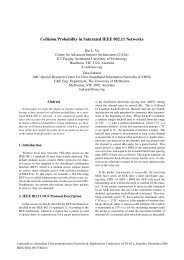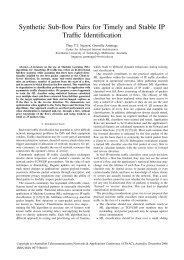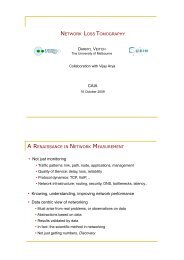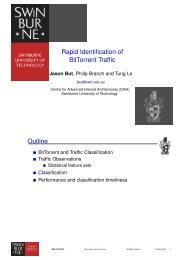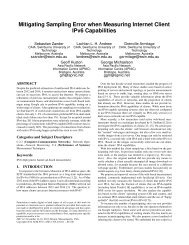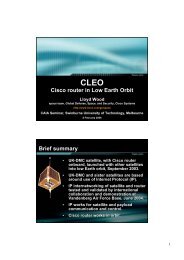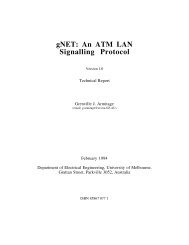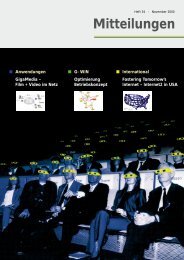Chapter 3 Time-to-live Covert Channels - CAIA
Chapter 3 Time-to-live Covert Channels - CAIA
Chapter 3 Time-to-live Covert Channels - CAIA
You also want an ePaper? Increase the reach of your titles
YUMPU automatically turns print PDFs into web optimized ePapers that Google loves.
Throughput (bits/s)<br />
60<br />
50<br />
40<br />
30<br />
20<br />
10<br />
0<br />
0.0 0.1 0.2 0.3 0.4 0.5<br />
Packet reordering (%)<br />
CHAPTER 3. TIME-TO-LIVE COVERT CHANNELS<br />
MED<br />
AMI<br />
DED<br />
Throughput (kbits/s)<br />
8<br />
6<br />
4<br />
2<br />
0<br />
0.0 0.1 0.2 0.3 0.4 0.5<br />
Packet reordering (%)<br />
Figure 3.23: Throughput depending on packet reordering for <strong>CAIA</strong> (left) and Leipzig (right)<br />
for 0.1% packet loss<br />
Capacity percentage<br />
100<br />
90<br />
80<br />
70<br />
60<br />
50<br />
l=0,<br />
r=0<br />
l=0.1,<br />
r=0<br />
l=0.5,<br />
r=0<br />
l=1.0,<br />
r=0<br />
Packet loss (l) and reordering (r) (%)<br />
l=0.1,<br />
r=0.1<br />
MED0<br />
AMI<br />
DED<br />
MED<br />
Figure 3.24: Percentage of capacity reached for the different modulation schemes and the<br />
different packet loss and reordering settings averaged across all traces<br />
We also measured the average block decoding speed of the receiver, which is defined<br />
as the length of a data block in bytes divided by the average decoding time of blocks. The<br />
differences between different modulation schemes are negligible, but there are significant<br />
differences between the different traces. The results show that even for the experiments<br />
with the highest error rate the decoder is still much faster than the actual throughput of<br />
the channel (see Appendix B.9).<br />
3.5.6 Throughput – testbed experiments<br />
In the testbed experiments we measured the throughput of the covert channel across a<br />
real network for different types of overt traffic. The covert channel was encoded in a<br />
single overt traffic flow. This setup is representative for a scenario where the overt traffic<br />
68<br />
l=0.1,<br />
r=0.5<br />
MED<br />
AMI<br />
DED



